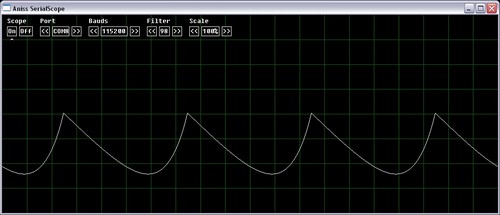Hi guys,
I'm currently programming a software oscilloscope based on C++ and DirectX, thus the performance is very good. It works directly off the serial/COM ports. I was just wondering..is anyone else interested in such a thing?
I'm programming it for my Arduino BUT it should be able to work with Picaxe(or anything else) too. It's not gonna be a fancy pro application, but it works pretty damn well :) For now it's rather limited since it only accepts 8 bit values...well for now...
Second..Any ideas for the user interface (since I've never actually seen a REAL live oscillocope..he he)?
So far I've got a start/stop button, select COM port, smoothing filter, scaling and BAUD rate selection...and that's about it for now...
Here is a screenshot:

I'll be updating as it moves along...Only minor details are missing before beta 0.1 is ready :)
.... Aniss
UPDATE: Well, 1st version is ready. Hope you guys will give me some feedback...Couldn't attach the RAR file here (?) so I uploaded it to here:
www.4shared.com/file/138189588/3813eae8/SerialScope.html
UPDATE: As promised here is the source code. It's still a bit messy but it IS a prototype. If you plan to actually compile this here is some info: It's made with Visual C++ 2008 express. It's based on Dark GDK which again is based on DirectX SDK, so both have to be installed first. I also used this Win32 based wrapper for the serial communication, so you'll have to add the files Serial.h and Serial.cpp to your project too. And that should be it.
Here is the source code:
www.4shared.com/file/138412518/630d2562/SerialScope_Source.html
PS: Still anxious to get feedback from people who actually used the program :)
UPDATE: Even though nobody seems to find it usefull :( here is the newest version of the SerialScope. It's faster, has X axis scaling, shows statistics (press RETURN to toggle on/off) and I removed the start up hickups (NOTE: You now have to start by sending off the string "START" to sync the scope with your MCU). Plus some other minor improvements.


